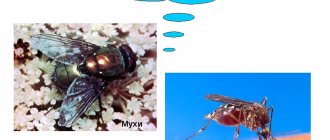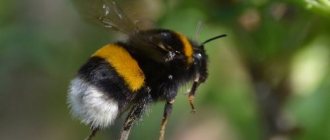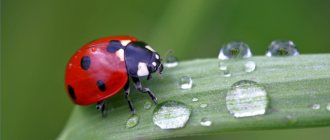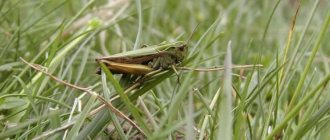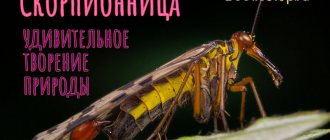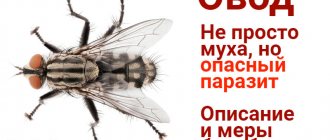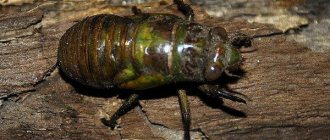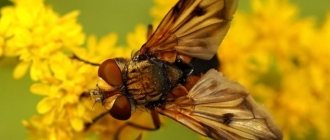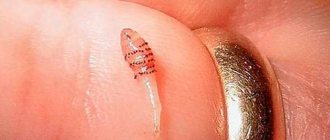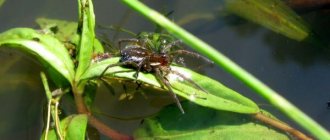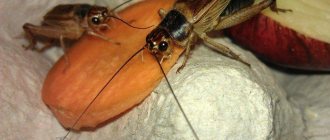Flies are synanthropic insects, whose life is closely connected with humans. They absorb liquid food. A weak proboscis cannot harm people or animals. But not all dipterans are harmless. The species autumn zhigalka is an active bloodsucker. It feeds on cattle, but can fly into houses and bite humans. The pest carries pathogens of dangerous diseases: anthrax, tularemia, staphylococci.
Appearance
The autumn flies (Stomoxyscalcitrans) are a species of true flies, a representative of the order Diptera. In appearance and organ structure it is close to the housefly. It is not surprising that insects are confused, surprising at their aggressiveness in the autumn. The zhigalka has a stocky body with a length of 5.5-7 mm. The body is gray, there are dark stripes on the chest, and black spots on the abdomen. There are four longitudinal stripes on the mesonotum. The head is large and mobile. There is a yellowish-white coating on the cheekbones. There is a dark stripe on the forehead. The antennae are short, sharp, black in color.
Most of the head is occupied by compound eyes. They play a significant role in the life of flies. Insects rely on vision to find food and escape from enemies. The body and head are articulated by a thin stalk. Their surface is covered with dark bristles. For flight, one pair of transparent wings is used. The limbs are thin and long, black.
The structure of the proboscis
To be able to pierce the skin of animals, zhigalki acquired a proboscis with special plates. The organ is hard, thin and long, protruding somewhat forward. It ends with special sucking plates covered with chitinous teeth. During an attack on an animal, the plates move, and a large number of teeth tear the surface layer of the skin. The color of the proboscis is black with a tint.
Larvae
At the larval stage, the offspring of the fireweed are yellowish-white. At the first instar they are transparent, the length of the flexible elongated body is 1.2 mm. By the third instar they grow to 11-12 mm. The body consists of 8 segments. There is a ring of small spikes on the chest. On the abdominal segments from the second to the seventh there are tuberous outgrowths. Spiracles on the eighth segment. The larva is limbless; it moves with the help of tubercles and spines.
Lifespan
We looked at what the Drosophila fly and some other species of these dipterans feed on. Let's find out how long they live and whether they can live without food.
The average lifespan of fruit flies under favorable conditions is short, only 10-20 days. However, if the temperature is up to +18 °C, and there is a lot of food, pests can live for more than 2.5 months. Diptera are almost never left without food, since they find food everywhere both in human homes and in nature. If necessary, they can eat food in garbage dumps and landfills. In winter, the insect goes into suspended animation and can survive without food until the first warm days. It should be remembered that newly awakened flies are very lethargic and it will not be difficult to kill them.
In forests, dipterans have a lot of natural enemies (birds, frogs, spiders), so they rarely survive more than 10 days.
We looked at what flies eat and were convinced that these creatures are able to survive almost anywhere, since they are not picky about food.
Features of reproduction
Male and female individuals of the autumn zhigalka differ in the structure of the genital organs and forehead. In males, the forehead is narrow, 2/3 the width of the eyes. Females have a fairly wide eye, almost identical in size. Flies are insects with complete metamorphosis. Their life cycle is only 5-20 days. 2-3 days after emerging from the pupa, the imago is ready for mating and procreation. To lay eggs, females choose places where organic matter decomposes - manure, compost heaps, haystacks.
In one clutch there are from 100 to 130 white, elongated eggs. During her life, one female makes 5-7 clutches. It takes 10-24 hours before the larva appears. During development, it molts twice and changes through three instars. At a temperature comfortable for flies (+27-30°C), after 4-5 days the larva turns into a pupa. The cover of the third instar hardens and acquires a red-brown color. Externally, the pupa is similar to a capsule, its length is up to 6 mm. There is a slight expansion on the head area. The spiracles are located on the border of the first and second segments. In hot weather, all stages from the egg to the adult of the fly pass through in 6 days.
Before pupation, the larvae move into manure with a moisture content of no more than 20-40%. The highest concentration is observed in a place with a temperature of +25°. The pupa can be located at a depth of up to 50 cm. Increased temperature and humidity negatively affect its condition. The development of the pupa takes 4-7 days, and a fully formed fly emerges from the cocoon.
Attention. The larvae of the autumn fly die at a temperature of +52°C.
Nutrition method
In our usual understanding of this word, burners do not bite. They scrape off the top layer of the epidermis with their proboscis, causing blood to appear. To prevent the blood from clotting, the burner releases poisonous saliva onto the scraping, the action of which leads to severe irritation.
On a note!
At one time, the female is able to drink a dose of blood twice her own weight.
Females need blood to complete the reproductive cycle. A hungry zhigalka will not be able to lay eggs. The desire to reproduce is the reason why this type of fly is especially biting in the fall.
Zhigalkas can overwinter at any stage of development, but already at temperatures below +8°C they hibernate. Before wintering, it is advisable for the female to have time to lay eggs. In the southern regions, at high air temperatures, this type of fly can breed all year round.
Lifestyle
The genus of true flies Stomoxys includes 18 species of various animal ectoparasites. The autumn fly Stomoxyscalcitrans is the only species that is found everywhere and is synanthropic. Insects are called village insects for their attachment to domestic animals. Flies choose where cattle live - barns, pastures. Large concentrations of autumn beetles are observed in illuminated areas. They warm themselves by sitting on the walls of the pen, tree trunks, and the ground. Diptera activity occurs only during the daytime.
At the end of summer, the population of the autumn zhigalka fly increases several times. During the warm season, less than seven generations of the harmful insect appear. Competition for food forces flies to explore new territories. During this period, they increasingly appear near people and fly into houses. Being a heat-loving species, they cease activity at a temperature of +8°C. They go to wintering at any stage - larva, pupa, imago. In favorable conditions, at a constantly high temperature of +15°C, the development process proceeds without interruption.
Nutrition
To live, insects need to eat once every 2-3 days. Sucking the blood takes 15 minutes. At the same time, the fly's abdomen swells greatly, it becomes heavy, and moves with difficulty. Zhigalki prefer to feed in the morning and evening, in cool weather - closer to noon. In autumn, insects' metabolism slows down and they feed less frequently; they can fast for up to 10 days.
Information. In large animals, burners are collected on the legs and stomach. Dogs suck blood by sitting in the ear area. People are bitten on the legs and elbows.
Habitat
Autumn flies are not picky and do not require special conditions. The main thing is that it is light and warm. That is why they are common almost everywhere.
The main places for the accumulation of livestock are pastures, cattle pens, and barns. Here the flies feel very comfortable, because there is both manure for laying and potential food - the blood of livestock. Flies feed only on blood, and at one time they are able to suck out an amount twice their own weight.
In warm weather, firebirds often bask on the sunny side of house walls and tree trunks, but once indoors, light-loving firebirds still try not to be seen too much, hiding in the shadows or behind and under furniture (this is why firebird bites often occur on the legs).
The harmfulness of burners
Males and females suck the blood of animals. They attack various animals:
- cows;
- goats;
- pigs;
- horses.
Dogs and people get bitten. Pets suffer greatly from attacks by blood-sucking flies. While feeding, the insect releases secretions from the salivary glands. The saliva of the zhigalka, which enters the proboscis from two channels, has poisonous properties. Livestock owners often have to watch animals kicking their hooves, bucking, waving their heads or tails. After being bitten, horses have pain and swelling in their knees. Animals find it difficult to stand. Cows' milk yield is reduced by 40-50%.
People tolerate the bite of the autumn fly in different ways. For some, this is a short sting, while others suffer from itching in the bitten skin for a long time. Unpleasant sensations and discomfort are not the only harm caused by flies. Blood-sucking insects carry various infections. When bitten, pathogens of dangerous diseases enter the bloodstream: sepsis, tularemia, anthrax, tuberculosis.
Attention. When animals are attacked by a large number of autumn firebirds, they lose weight. Constant irritation and pain have a negative impact on health.
Why is it dangerous for humans?
Diseases transmitted by the zhigalka
Like any “reusable” bloodsucker, the zhigalka is capable of transmitting dangerous diseases to humans:
- relapsing fever;
- tularemia;
- trypanosomiasis;
- ehrlichiosis;
- anthrax.
Flies often land on decaying carrion, catching pathogenic bacteria on their legs and proboscis. In this case, when feeding on blood, they can introduce bacteria into the wound. But the risk of sepsis in this case is minimal. The human body is able to resist a small number of pathogenic bacteria. Microorganisms brought from carrion are dangerous only to people with a dysfunctional immune system.
On a note!
The transfer of dysentery pathogens and worm eggs is a common function of all flies, including the autumn flies.
First aid for burner bites
Harmful insects most often choose helpless victims among people - small children, disabled people, sleeping people. They usually bite on the legs. Due to the poisonous saliva injected into the wound, a burning sensation and swelling appears.
The injured person must be given first aid:
- Cool the affected area by applying ice.
- Treat the wound with an antiseptic.
- Soda lotions are recommended to relieve itching.
- People prone to allergies should be given an antihistamine.
- If a day or two after the bite the victim feels unwell, he should go to the hospital. Possible infection.
Harm to animals
The danger of moose fly for animals
Hunters counted up to 300 individuals on the body of one deer. The pest is able to stick tightly to the fur and cannot be torn off even with teeth.
- The bite of an elk fly causes pain, discomfort, and after a while inflammation of the affected area, swelling, and itching.
- Animals react painfully to the attack of parasites, sleep poorly, and lose strength.
- In domestic cows, the amount of milk decreases, and beef breeds of cattle lose weight.
- The tick-like fly is especially dangerous for young animals. If the infection is severe, calves become ill, are delayed in development, and even die.
- The wool comes in clumps and takes on a sloppy appearance. The wounds often become infected and begin to fester.
- During the day, the female feeds about 20 times and drinks about 1.5 ml of blood in one procedure. With severe infection, young animals die from anemia, adults become weak and sickly.
Control measures
To destroy blood-sucking pests, mechanical and chemical control methods are used.
Mechanical
- Installation of mosquito nets on windows and doors.
- The use of fly traps, which are made from a plastic or glass container with bait inside.
- Strips of adhesive tape hung throughout the premises. An effective and safe product that attracts insects, but has no odor for humans.
Chemical
It is not possible to prevent the spread of insects using mechanical methods alone. Chemicals will be required for complete extermination.
- Systemic insecticides and poisoned baits are used against adults.
- Special pesticides - larvicides - help destroy larvae and pupae.
Tsetse
- This fly has twice as much vitamin C as a regular fly (just kidding)
- African viviparous blood-sucking fly: carrier of sleepy and some other diseases
- another name for the African fly, glossina
- a genus of blood-sucking flies, common in the tropics and subtropics of Africa
- fly with vitamin C
- bloodthirsty African fly
- this fly was the first link in the chain of evidence that Jules Verne's heroes ended up in Africa, and not in America
- insect, fly
- fly in Africa, carrier of sleepy and some other diseases
- fly from Africa
- African fly
- bloodthirsty fly
- “fly with vitamin C” (anecd.)
- African fly in the service of Morpheus
- fly biting Papuans
- fly
- African pest fly
- sleep-inducing fly
- African clatter fly
- imported clattering fly
- African fly as a sleeping pill
- African fly - “hypnotist”
- sleepy fly
- fly from Zanzibar
- the clattering fly is native to Africa
- dangerous fly
- dangerous African fly
- African fly as a hypnotist
- African fly as a hypnotist
- African fly as a sleeping pill
- African sleepy fly
- African fly as a sleeping pill.
header>
How to protect your home
Many plants have a scent and secrete special enzymes that repel these insects. At your summer cottage, it is good to plant bushes of bird cherry, currant, and black elderberry under the windows; these bushes will provide environmental protection to the house and flies will fly around it. Bouquets of the following herbs are also used:
- succession leaves;
- celandine;
- St. John's wort.
For apartments, the most suitable are geranium and tansy. By placing several pots with these plants on the windowsill, you can secure your apartment; bloodsuckers will not fly in and bite. In addition, geranium helps to significantly reduce the likelihood of mosquitoes, beetles, and ticks; these insects, which are also often annoying in the summer, cannot tolerate the smell of geranium.
An insect repeller can be installed in apartments; an ultrasonic device produces a low-frequency sound that is not audible to the human ear, but is well recognized by insects as a danger signal.
Keeping garbage cans, waste storage containers clean, and preventive treatment of cesspools in a summer cottage will ensure a significant reduction in the number of parasites, and as a result, the comfort of the home.
Preventive measures
To prevent the appearance of pests, it is important to carry out preventive measures. Excellent conditions for the reproduction and residence of pests - heat, humidity, presence of organic waste
Therefore, the following rules must be observed:
- Keep the house, sheds and yard clean. Remove dirt in a timely manner, throw out garbage (preferably once every 1-2 days), do not leave dirty dishes with food residues, regularly ventilate the room.
- Take care of pets and birds. Remove droppings from them, clean their habitats, and wash the animal if necessary.
- Keep the area clean - cover trash containers, mow the lawn on time, remove old grass and fallen leaves, remove dog droppings, fill cesspools with bleach or any other septic tank.
- Monitor the condition of ponds on the site. Standing water creates favorable conditions for various insects, so you need to make sure that it does not rot and silt does not form.
- Properly store the harvest. The putrid smell of spoiling vegetables and fruits attracts flies, this is a real feast for them!
- Install mosquito nets. Now mosquito nets are made to any size. It is advisable to install them on windows, vents, doors, ventilation holes.
We answered in detail the question - how to deal with flies in a summer cottage. Once you start the fight, it is best to take an integrated approach - use chemicals, folk remedies, and various traps.
Traditional methods of protection
At a time when there were no specially designed insect repellents, people came up with various ways to protect themselves and their pets from annoying biting flies.
It must be diluted with water, maintaining a 1:1 ratio. Otherwise, soft tissue may be damaged. The treatment is carried out on the inside of the ear; it must be wiped with a piece of cloth soaked in the solution. This protective agent can save a dog from flies for a short time, as it quickly disappears. Therefore, it is necessary to re-treat the animal’s ears at certain intervals.
Apply vinegar solution to dog ears
It should be borne in mind that an aqueous solution of vinegar can only be used if the flies have not yet had time to bite the dog. Any violation of tissue integrity is a contraindication to the use of this product.
The resulting liquid is used to treat problem areas. A decoction of these herbs will not only repel annoying flies, it is also an antiseptic. They can be used to treat bite sites.
If you don’t want to prepare a decoction, you can purchase essential oils of lavender, eucalyptus or fir. Before use, you must dilute them with water. The resulting solution is used to treat the dog’s ears.
Lubricate your pet's ears with a decoction of herbs.
Tar soap is an old folk method of fighting flies. This product has a persistent specific odor that is unpleasant for insects.
In addition to using protective equipment, pet owners should carefully monitor the cleanliness of their dogs' ears. The dirt and sulfur smell attracts flies. For this reason, it is necessary to clean your ears regularly and keep them clean and dry.
Characteristics of an insect
The forest fly, or as it is also called the moose bloodsucker, lives in:
- North America;
- Primorsky Krai;
- northern part of China;
- Siberia;
- European part of Russia.
An adult reaches 3.5 cm. The body shape is flattened, so the insect is difficult to crush. The color of the pest is light brown. There are dark compound eyes on the head. The mouthparts resemble the proboscis of an autumn fly. The wings are small and oval in shape. Their length is 6 mm.
The forest fly is a viviparous insect. The larva is gestated in the abdomen. “Pregnancy” lasts 20 days. Larvae are born every 3 days. During the season, the insect gives birth to 30 “cubs”.
After hatching, the larvae harden. After this they fall to the ground. The first puparia are formed by the end of August. The larvae, born in late autumn, continue to develop only with the onset of warm spring days.
Important: the full development cycle lasts 2 years. Adults hide in the grass, waiting for passing prey
Having “mounted” a deer or other animal, the pests begin to feed on blood. Thanks to their tenacious legs, they are attached to the fibers. An animal can shed them only during molting.
Adults hide in the grass, waiting for passing prey. Having “mounted” a deer or other animal, the pests begin to feed on blood. Thanks to their tenacious legs, they are attached to the fibers. The animal can shed them only during molting.
Fly bite: local symptoms and physiological changes
The body's reaction to a fly bite occurs due to mechanical damage to the skin and the toxic effect of saliva, and symptoms may be local in nature or reflected in changes in the general condition of the body. Farm animals suffer from attacks of blood-sucking parasites much more than humans.
A small pinpoint wound and a red bump around it are the main external manifestations of a fly attack. After an attack by a large number of insects, the body may be covered with many bites located at some distance from each other. The following symptoms indicate complications:
- redness and swelling increase;
- children may develop hives;
- suppuration has formed near the wound due to the penetration of a secondary infection;
- The elevated body temperature does not subside for several days, general weakness and sleep disturbance are observed.
In animals, after multiple and regular fly bites, the volume of milk yield, meat gain, and the quality of wool deteriorate significantly. Scratches, ulcers and other damage that require treatment appear on the skin.
